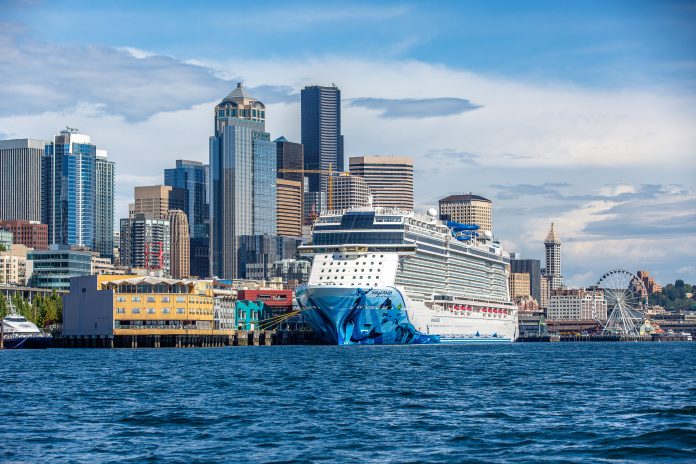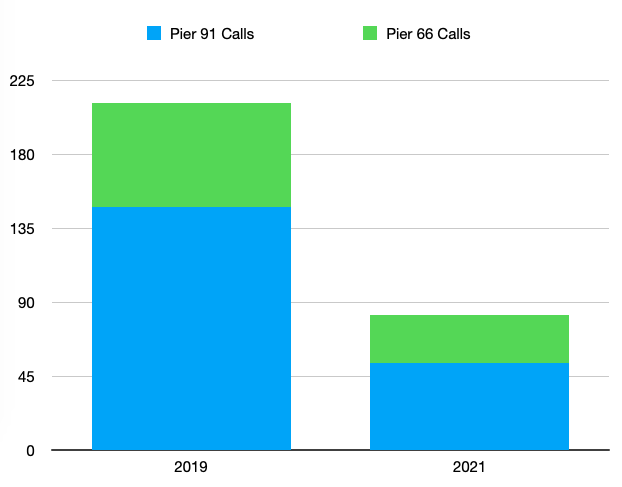In February of 2020, with the coronavirus impacting the cruise industry in Asia, there was a brief moment when it looked like the Seattle cruise industry would get a benefit from what wasn’t clearly a worldwide pandemic at that time. Celebrity Cruises’ ship the Millennium would be diverted from Singapore and start the Seattle and Alaska cruise season early. Those planned April sailings never happened, of course, as Covid-19 cancelled the entire 2020 Alaska cruise season in late March. But at the time, the Port of Seattle’s Director of Cruise Operations, Michael McLaughlin, noted one benefit of the Millennium‘s planned visit to Seattle. “It will be the first Celebrity-branded ship to connect to shore power,” McLaughlin told the Puget Sound Business Journal at the time.
Shore power allows the ship to plug into the local electrical grid; without it the cruise ship is essentially using the same power system that it does at sea, emitting all of the carbon and diesel fumes that come along with it. The Millennium was being retrofitted to run on shore power before it arrived in Los Angeles, a few stops before arriving in Seattle. At the time, Celebrity touted this improvement in a press document. “This will allow us to benefit from the great shore power resource available at the Port of Los Angeles and ensure that we continue to make strides towards minimising [sic] our impact on this beautiful planet,” the document stated.
But that retrofit never occurred as more plans were upended by the pandemic. And when the Millennium calls on Seattle this summer, 11 of its 12 planned sailings will be at Pier 66 in Belltown, which doesn’t have shore power capabilities. Unlike in Los Angeles, utilizing shore power is not seen as a prerequisite for serving the Port of Seattle.
The reason for these restrictions are clear: cruise ship emissions are particularly nasty. While power-generating systems vary by ship, cruise ships burn heavy fuel oil, which is the dirtiest of fossil fuels, for propulsion and most do not have diesel particulate filters or catalytic converters to clean the exhaust. Because heavy fuel oil is so high in sulfur, one study found that in the European Union, Carnival cruise lines alone produced ten times more disease-causing sulfur dioxide than the 260 million cars on the continent. In lieu of separate power generators, some cruise ships simply run their heavy fuel oil engines to produce power when docked. A large cruise ship can burn as much as 80,000 gallons of fuel per day when travelling at full speed.
The Port of Seattle has added shore power capabilities on both of its two cruise berths at the Pier 91 terminal in Interbay, but is still working on adding the ability to connect to shore power at its third berth at Pier 66. According to the Port of Seattle, shore power capabilities will not be ready until the start of the 2023 cruise season, nearly two years away. That’s one additional year of diesel emissions impacting Belltown residents and visitors on top of this one. One ship utilizing shore power at Pier 91 avoids the emissions equivalent to “an average car driving from Seattle to New York 30 times,” according to the Port of Seattle. For the 2021 season, there are 29 sailings currently scheduled at Pier 66 across three separate cruise ships, to say nothing of the prep work currently underway as the ships conduct trial runs in advance of the start of the season on July 19th.
The Norwegian Encore is another of the three ships scheduled to call on Pier 66. In 2015, Norwegian Cruise Lines signed a 15-year agreement with the Port of Seattle; two years later a revamped Pier 66 opened after a $30 million renovation split between the port and the cruise line. Except, the Encore is fully shore power capable, emissions that could be captured if the ship were berthed at Pier 91 instead.
Port of Seattle spokesperson Peter McGraw said Pier 91 is only being utilized for one ship loading or unloading passengers at any one time. That means its capacity is significantly reduced compared to normal years, even though Pier 91 could accommodate most of the 2021 cruise traffic on its own — in 2019, it accommodated 148 sailings. This year it’s set to see only 53. That means Pier 66, without shore power capabilities, is set to actually see a larger percentage of total Seattle cruise traffic in 2021 than it did in 2019. Even if a ship weren’t equipped with shore power capabilities, moving it from Pier 66 to Pier 91 could reduce the impact seen on an adjacent high-density residential neighborhood in Belltown; Pier 91 is much more removed from residential areas.
Could more ships utilizing Pier 66 have been pressured into retrofitting with shore power capabilities in order to utilize Port of Seattle facilities and had their locations shifted to Pier 91? Could Norwegian Cruise Lines have accommodated the fact that a climate emergency might mean they won’t get to use Pier 66 until it sees shore power in 2023? These are good policy questions to consider as half of the Port of Seattle Commission seeks reelection this year and the candidates uniformly tout their environmental credentials as they open the doors to sending diesel fumes into Belltown’s streets.
Ryan Packer has been writing for The Urbanist since 2015, and currently reports full-time as Contributing Editor. Their beats are transportation, land use, public space, traffic safety, and obscure community meetings. Packer has also reported for other regional outlets including Capitol Hill Seattle, BikePortland, Seattle Met, and PubliCola. They live in the Capitol Hill neighborhood of Seattle.




